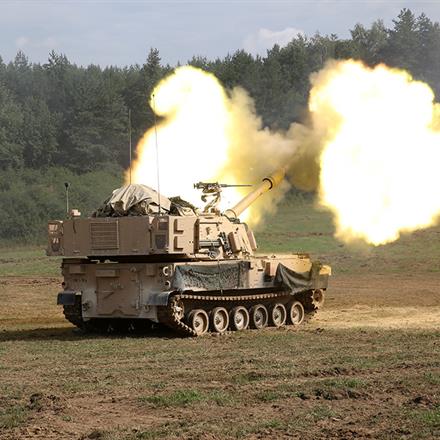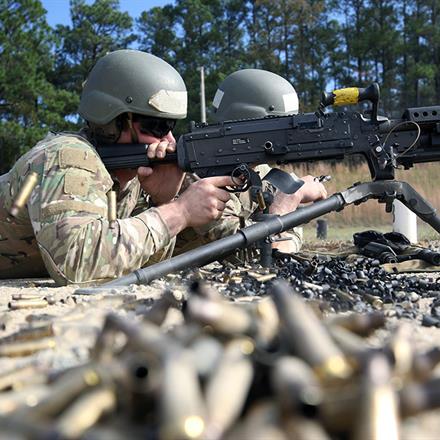Mechanical Shock (Acceleration/Deceleration)
 The delivery of a mechanical impulse transmitted to an individual or body part by the acceleration or deceleration of an inertial force. Potential exposures to mechanical shock include the opening force of a paratrooper's parachute harness1,2 and the firing of large caliber weapon systems exhibiting whole-body recoil forces (e.g., howitzers).
The delivery of a mechanical impulse transmitted to an individual or body part by the acceleration or deceleration of an inertial force. Potential exposures to mechanical shock include the opening force of a paratrooper's parachute harness1,2 and the firing of large caliber weapon systems exhibiting whole-body recoil forces (e.g., howitzers).
Data Requirements
The APHC has not established data requirements for assessing mechanical shock. It is anticipated that data requirements will include a method to measure acceleration either directly from an accelerometer or indirectly through calculation. Since most exposures occur while the body is in close contant with equipment, it may also be necessary to use a force gauge to measure forces transmitted to the body at those contact locations. Exposure is evaluated using a systems approach, and requires a description of all system components, including personal protective equipment, clothing, and other equipment.
Health Protection Criteria
Numerous biomechanical studies provide useful insights into the amount of mechanical shock that specific human tissues tolerate. Because most studies have either been conducted on cadavers or, most commonly, on isolated anatomical specimens, it is often difficult to apply the study data to the types of exposures encountered in dynamic military work environments. Mechanical shock interacts differently with intact, living subjects than with tissues studied in isolation. To ensure similarity between the research conditions and the military operation being targeted, caution should be observed when applying biomechanical injury criteria to military operations.
Typical recommendations may include implementing interventions to control the rate of velocity change or alter the forces transmitted through contact points with the human. Forces at contact locations may be moderated by increasing the surface area of the contact, adding cushioning, or incorporating a harness or suspension.
Recoil
Reactive force from the discharge of a firearm, often called “kick,”
that propels the weapon backwards and imparts mechanical force to
the point of contact with the Soldier's body (usually the shoulder or wrist). The recoil momentum balances the forward momentum of the projectile and propellant gases according to Newton's Third Law, the conservation of momentum. The magnitude of recoil force delivered to the operator is dependent upon several factors including the design of the weapon as well as firing technique.
imparts mechanical force to
the point of contact with the Soldier's body (usually the shoulder or wrist). The recoil momentum balances the forward momentum of the projectile and propellant gases according to Newton's Third Law, the conservation of momentum. The magnitude of recoil force delivered to the operator is dependent upon several factors including the design of the weapon as well as firing technique.
Data Requirements
Data requirements for recoil are currently being developed. It is anticipated that data requirements will necessitate conducting a weapon kinetics study. Specific data items required to assess the risk of injury from recoil will likely include measurements of weapon acceleration, weapon speed, and displacement along the axis of the weapon that aligns with the anatomical point of contact with the operator. Factors used to calculate recoil energy are also needed (e.g., weights of the gun, propellant, and bullet). Detailed use scenario information is needed, including the duration of exposure and anticipated number of rounds that may be fired on a typical training or operational day.
Health Protection Criteria
Currently, no Army-approved health protection criteria or medical models have been established for recoil exposures. TOP 03-2-504A contains the following design criteria and recommended test weapon firing limitations:3
Recoil-based Firing Limitations for Test Weapons
| | Computed Recoil Energy | Limitations on Rounds | |
| | Less than 15 ft-lb (20.3 joules) | Unlimited firing | |
| | 15 to 30 ft-lb (20.3 to 40.7 joules) | 200 rounds/day/man | |
| | 30 to 45 ft-lb (40.7 to 61.0 joules) | 100 rounds/day/man | |
| | 45 to 60 ft-lb (61.0 to 81.4 joules) | 25 rounds/day/man | |
| | Greater than 60 ft-lb (81.4 joules) | No shoulder firing | |
The validity of these design criteria as a basis for health protection criteria for HHAs has not been substantiated. Studies have advised conducting additional research to obtain the data needed to develop a more definitive characterization of recoil exposure and health protection criteria.4,5
For more information and guidelines for assessing musculoskeletal trauma, see Technical Guide 351C, Health Hazard Assessor's Guide.
References
(1) U.S. Army Public Health Center. 2019. Technical Information Paper No. 12-095-0219, Injuries Among Military Paratroopers—Current Evidence and Data Gaps. Aberdeen Proving Ground, Maryland. 
(2) U.S. Army Research Laboratory. 1995. AL-TR-926, Lower Extremity Assistance for Parachutist (LEAP) Program: Quantification of the Biomechanics of the Parachute Landing Fall and Implications for a Device to Prevent Injuries. 
(3) ATEC. 2013. TOP 03–2–504A, Safety Evaluation of Small Arms and Medium Caliber Weapons. 
(4) Blankenship K, Evans R, Allison S, Murphy M, Isome H. 2004. U.S. Army Medical Research Institute of Environmental Medicine, Report No. T04-05, Shoulder-fired weapons with high recoil energy: Quantifying injury and shooting performance. 
(5) Burns BP. 2012. U.S. Army Research Laboratory, Report No. ARL-CR-692, Recoil Considerations for Shoulder-fired Weapons. 
